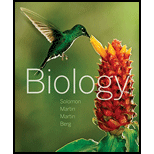
Concept explainers
Introduction: The most advanced placental mammals are the primates. Primates are mammals that lead an arboreal mode of life, except humans who lead terrestrial mode of life. They evolved during the Cenozoic era. The primate evolution began from Africa and there are several excavated evidences to support this theory.
Answer to Problem 1TYU
Correct answer: The first primates evolved from shrew-like placental mammals. Hence, the correct answer is option (c).
Explanation of Solution
Reasons for the correct answer:
Evolution of animals is often explained with the help of fossil evidences, body structure, and DNA analysis of fossils. Based on the available evidences, paleontologists hypothesize that shrew-like placental mammals are the immediate ancestors of the first primates that evolved. The earliest known primate is Plesiadapis, which shares several features with shrews.
Option (c) is given as “shrewlike placental mammals”.
The first primates shared several features with the shrews; hence, they are said to have evolved from shrew-like placental mammals. Thus, the correct answer is option (c).
Reasons for incorrect answers:
Option (a) is given as “shrewlike monotremes”.
Shrewlike monotremes are not the ancestors of the first primates. Montremes are not placental mammals. Primates are placental mammals. Hence, option (a) is incorrect.
Option (b) is given as “therapsids”.
Therapsids gave rise to the first mammals. They are not the direct ancestors of primates. Shrew-like placental mammals are the direct ancestors of the primates. Hence, option (b) is incorrect.
Option (d) is given as “tarsiers”.
Tarsiers are not the first primates. They are the second level of primates to have evolved. Tarsiers evolved from Simians. Hence, option (d) is incorrect.
Option (e) is given as “shrewlike marsupials”.
Shrewlike marsupials are not the ancestors of the first primates. Marsupials are not placental mammals. Primates are placental mammals. Hence, option (e) is incorrect.
Hence, options (a), (b), (d), and (e) are incorrect.
The first primates shared several features with the shrews; hence, they are said to have evolved from shrew-like placental mammals.
Want to see more full solutions like this?
Chapter 22 Solutions
Biology (MindTap Course List)
- Skryf n kortkuns van die Egyptians pyramids vertel ñ story. Maximum 500 woordearrow_forward1.)What cross will result in half homozygous dominant offspring and half heterozygous offspring? 2.) What cross will result in all heterozygous offspring?arrow_forward1.Steroids like testosterone and estrogen are nonpolar and large (~18 carbons). Steroids diffuse through membranes without transporters. Compare and contrast the remaining substances and circle the three substances that can diffuse through a membrane the fastest, without a transporter. Put a square around the other substance that can also diffuse through a membrane (1000x slower but also without a transporter). Molecule Steroid H+ CO₂ Glucose (C6H12O6) H₂O Na+ N₂ Size (Small/Big) Big Nonpolar/Polar/ Nonpolar lonizedarrow_forward
- what are the answer from the bookarrow_forwardwhat is lung cancer why plants removes liquid water intead water vapoursarrow_forward*Example 2: Tracing the path of an autosomal dominant trait Trait: Neurofibromatosis Forms of the trait: The dominant form is neurofibromatosis, caused by the production of an abnormal form of the protein neurofibromin. Affected individuals show spots of abnormal skin pigmentation and non-cancerous tumors that can interfere with the nervous system and cause blindness. Some tumors can convert to a cancerous form. i The recessive form is a normal protein - in other words, no neurofibromatosis.moovi A typical pedigree for a family that carries neurofibromatosis is shown below. Note that carriers are not indicated with half-colored shapes in this chart. Use the letter "N" to indicate the dominant neurofibromatosis allele, and the letter "n" for the normal allele. Nn nn nn 2 nn Nn A 3 N-arrow_forward
- I want to be a super nutrition guy what u guys like recommend mearrow_forwardPlease finish the chart at the bottom. Some of the answers have been filled in.arrow_forward9. Aerobic respiration of one lipid molecule. The lipid is composed of one glycerol molecule connected to two fatty acid tails. One fatty acid is 12 carbons long and the other fatty acid is 18 carbons long in the figure below. Use the information below to determine how much ATP will be produced from the glycerol part of the lipid. Then, in part B, determine how much ATP is produced from the 2 fatty acids of the lipid. Finally put the NADH and ATP yields together from the glycerol and fatty acids (part A and B) to determine your total number of ATP produced per lipid. Assume no other carbon source is available. 18 carbons fatty acids 12 carbons 9 glycerol A. Glycerol is broken down to glyceraldehyde 3-phosphate, a glycolysis intermediate via the following pathway shown in the figure below. Notice this process costs one ATP but generates one FADH2. Continue generating ATP with glyceraldehyde-3-phosphate using the standard pathway and aerobic respiration. glycerol glycerol-3- phosphate…arrow_forward
 Biology (MindTap Course List)BiologyISBN:9781337392938Author:Eldra Solomon, Charles Martin, Diana W. Martin, Linda R. BergPublisher:Cengage Learning
Biology (MindTap Course List)BiologyISBN:9781337392938Author:Eldra Solomon, Charles Martin, Diana W. Martin, Linda R. BergPublisher:Cengage Learning Biology: The Dynamic Science (MindTap Course List)BiologyISBN:9781305389892Author:Peter J. Russell, Paul E. Hertz, Beverly McMillanPublisher:Cengage Learning
Biology: The Dynamic Science (MindTap Course List)BiologyISBN:9781305389892Author:Peter J. Russell, Paul E. Hertz, Beverly McMillanPublisher:Cengage Learning
 Concepts of BiologyBiologyISBN:9781938168116Author:Samantha Fowler, Rebecca Roush, James WisePublisher:OpenStax College
Concepts of BiologyBiologyISBN:9781938168116Author:Samantha Fowler, Rebecca Roush, James WisePublisher:OpenStax College Biology: The Unity and Diversity of Life (MindTap...BiologyISBN:9781337408332Author:Cecie Starr, Ralph Taggart, Christine Evers, Lisa StarrPublisher:Cengage Learning
Biology: The Unity and Diversity of Life (MindTap...BiologyISBN:9781337408332Author:Cecie Starr, Ralph Taggart, Christine Evers, Lisa StarrPublisher:Cengage Learning Biology: The Unity and Diversity of Life (MindTap...BiologyISBN:9781305073951Author:Cecie Starr, Ralph Taggart, Christine Evers, Lisa StarrPublisher:Cengage Learning
Biology: The Unity and Diversity of Life (MindTap...BiologyISBN:9781305073951Author:Cecie Starr, Ralph Taggart, Christine Evers, Lisa StarrPublisher:Cengage Learning





